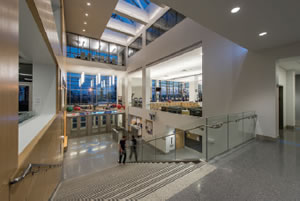Model Behavior
Costs will need to come down and construction projects will need to align with tangible benefits before BIM can really take hold in the education sector.

RENDERINGS COURTESY OF STANMAR INC.
According to the latest industry research, more than 70 percent of architects, engineers and contractors now use building information modeling (BIM) to some degree in the design and construction of new buildings.
Yet, it is unlikely that anywhere close to 70 percent of building owners have embraced BIM or understand its nuances, in spite of frequent declarations of its potential benefits in the ongoing operation and maintenance of institutional buildings. Even though this “next new thing” is 30 years in the making, for most campus administrators it still qualifies as futurespeak. The primary reasons are cost and complexity — in the case of most institutional projects, too much of each to justify its implementation.
BIM is a catchall term that is too complicated for just one catchall term. In the design and construction industry, it refers to the process by which each member of the project team adds discipline-specific information to a single shared database from which detailed, three-dimensional digital representations of a building can be created. Used post-occupancy, this information can be expanded and shared by facility management personnel, with the goal of a building that is easier to maintain or performs better over time (in terms of cost control or other operational criteria).
Sounds great, right? Theoretically, yes. But there’s always a caveat.
Why We Use It — Some of the Time
Architects have been using computeraided design (CAD) for decades, mostly in a two-dimensional format, to efficiently produce electronic drawings. This mode of drafting eclipsed drawing by hand once the ease of reproduction and modification of drawings was fully realized. Likewise, BIM has entered the scene, filling niche needs for three-dimensional modeling and graphics but has not overtaken CAD, which still proves more than sufficient for all but the most complex projects.
BIM’s real selling point is its ability to make extremely complex systems easy to visualize and evaluate within the larger context of the entire construction project. An example of a successful BIM application was the troubleshooting of a reciprocating compressor in the underground floor of the Shanghai Disaster Tolerance Center, as outlined in a research article in Advances in Civil Engineering this year, “Engagement of Facilities Management in Design Stage through BIM: Framework and a Case Study.” BIM is a very useful tool in the design of hospitals and petrochemical facilities, where vast, expensive mechanical and piping systems require exacting detail, and the power of BIM in coordinating these designs and providing information for servicing and maintenance is a lifesaver. Without BIM, one could look at a drawing in two dimensions all day long and hardly begin to figure out how a mechanical plant’s systems fit together.
The limiting factor in BIM’s widespread use is cost. Much has been written about the savings from streamlining attributable to BIM, all of it true. When creating construction documents, different solid or void spaces are entered as separate components that are linked and defined in relation to each other — meaning that different views generated from the drawings are consistent and change automatically when one object related to other objects is altered. As a bonus, if the elements are entered with specific materials and product information, BIM can provide cost estimates and allow for automatic product ordering and tracking.
Unfortunately, many BIM enthusiasts fail to account for the significant cost to enter all that helpful data. There is both a cost to all members of the project team (inevitably passed on to the building owner) to spend the necessary time to input all relevant information, down to the last part number, on every piece of equipment in the building, and a management cost. Many project teams find it necessary (and desirable) to hire or appoint a BIM manager. While owners with sophisticated facility management teams might recognize the long-term savings implicit with full BIM capability and integration, smaller schools recognize BIM as an expense that will likely not significantly benefit their operation of the facility.
On the design side, BIM’s role will continue to advance and eventually become the new standard. BIM’s more comprehensive approach offers some tangible benefits from a design standpoint, key among them the ability to model the impact of changes to any building system all the way down to individual nuts and bolts. Integrating information from different disciplines means you can make a change and have that change flow through a number of different drawings without the potential of having it lost and not picked up by contractors or subcontractors. As the benefits curve merges with the cost curve, we will see BIM integrated throughout the design and construction industry.
As design-builders, we’re more than a little amused when we hear BIM described as something close to a panacea for a fractured construction process. ArchDaily last year published “A Brief History of BIM,” which under the heading “Towards a Collaborative Architecture” noted that BIM “has had impacts on the larger industry, including a movement away from design-bid-build contracts towards integrated project delivery, where many disciplines typically work on a mutually accessible set of BIM models that are updated in varying degrees of frequency.” In our view, prospective building owners can opt for BIM software to help foment a collaborative process, or they can hire a design-build firm, where an integrated project delivery is already the norm.

PHOTO © GREGG SHUPE 2013|SHUPESTUDIOS.COM, COURTESY OF STANMAR INC.
OH, I SEE… BIM enables the creation of high-value designs by allowing designers to analyze and visualize a design more clearly than ever before. Contractors can then communicate and collaborate with engineers and sub-contractors more efficiently, so as to avoid mistakes and reworks. The BIM-generated renderings on page 18 of the recently completed Steve Tisch Sports and Fitness Center on the campus of Tufts University in Medford, MA, illustrate the detailed accuracy of how BIM can depict the final result, shown in the photograph above. The resulting design became a signature facility for Tufts, meeting the university’s programmatic needs, unifying its existing historic buildings and keeping within its budget.
BIM’s Promise
The cost of inputting data when considering BIM as part of facilities management remains a large obstacle, but the monitoring of buildings throughout their lifespan really is the future, especially in this era of sustainability.
BIM’s Wikipedia entry hints at its potential empowerment of building owners by including an example of a water leak. At a glance, an owner can see that a valve is located at the suspected source of the leak, as well as the valve’s size, part number and manufacturer’s name and any notes of previous repairs to piping in that sector, thereby significantly simplifying the management of the problem. (Though the entry fails to note this, it’s worth mentioning that in the end, someone simply needs to fix the leak.)
Short of a flood, there are other circumstances where a visual representation, together with historical data, is helpful — for example, recurring maintenance such as lamp replacement over a gymnasium. (The data can aid in keeping tabs on frequency of lamp replacement and can identify problems, such as bad ballasts, which might not otherwise be recognized.) BIM also offers a good repository for information that can help analyze the performance of mechanical systems, sensors and the like. Enthusiasts speak of BIM as having five dimensions (time and cost being the non-spatial dimensions), and when the database is built to that level of detail, BIM does indeed function like a historical inventory of the building. This is useful data but requires the manpower investment to maintain the database — although when viewed over the lifespan of the building, this investment might be justified.
Building owners interested in integrating BIM technology into their facility management should invest time thinking about the following four areas:
- Management. Consider appointing or hiring a BIM manager.
- Goals. Determine your goals for BIM from the beginning of the design process. This will ensure you pay only for information you’ll actually need.
- Scope. Determine what information will be embedded in the BIM model, and which members of the project team will manage this information.
- Format. Consider in what format the architect will deliver BIM. Compatibility with the building owner’s computer capabilities is obviously vital, and frequently overlooked by those owners eager to apply new technologies.
Like a lot of technological advances, BIM, unless properly managed, won’t live up to its advance billing. For facility management teams that already have systems in place for capturing building information, BIM is a natural next step that, by bringing a visual element to data, can make it easier to manage. The large amount of data entry it requires, and the dollar investment behind it, has hindered BIM’s wider acceptance, but the continual progression of cost economy and value integration will soon (within five to 10 years) make BIM another useful tool in facilities management’s toolbox.
This article originally appeared in the College Planning & Management November 2013 issue of Spaces4Learning.